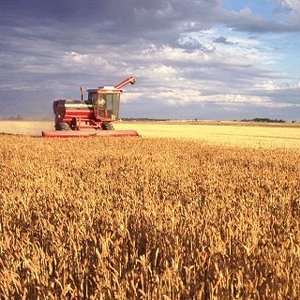U.S. Farm Profit Plunging on Lower Crop, Dairy Prices

Profits for U.S. farmers will plunge more than expected this year, dropping 38 percent from 2008 as the recession erodes demand for crops, livestock and dairy products, the government said.
Net farm income will sink to a seven-year low of $54 billion, down from a February forecast of $71.2 billion and last year’s estimated $87.2 billion, the U.S. Department of Agriculture said today in a report. Farm-product sales are dropping faster than costs for energy and feed, the USDA said.
The price of corn, the biggest U.S. crop, has plunged 46 percent in the past year, hog farmers lost an estimated $4.5 billion since September 2007, and dairy herds are being culled because of a milk surplus. Profits have declined for grain processors including Cargill Inc. and makers of farm equipment such as Deere & Co. and Agco Corp.
“Hogs were devastated by the H1N1 flu, and dairy isn’t getting off the mat,” said Bruce Babcock, the director of the Center for Agricultural and Rural Development at Iowa State University in Ames. “The outlook for crops is rosier.”
Falling Crop Values
Crop receipts will decline 9.8 percent to $164.7 billion, and livestock revenue will fall 15 percent to $118 billion, as input costs fall 6.4 percent, the USDA said.
The total value of farm production for 2009, which includes rent, government aid and other benefits from agricultural operations, is projected at $322 billion, down 12 percent from last year, the department said.
The report may signal a second straight year of lower farmland values, which fell 3.2 percent in 2008 after 21 years of gains, as well as less spending on farm equipment, said Dan Manternach, director of agricultural services at Doane Advisor Services Co. in St. Louis. Lower profits will probably have little impact on fertilizer or seed costs, he said in an e-mail.
Corn, wheat and soybean prices have plunged from records reached last year, and lower input costs aren’t helping farmers who made most of those purchases as early as one year ago, said Darrin Ihnes, who grows all three crops about 25 miles (40 kilometers) southwest of Sioux Falls, South Dakota.
‘Struggling’ Ethanol Industry
“The ethanol industry is struggling, the livestock industry is struggling, and crops are starting to struggle as well,” Ihnes said. Next year should be better as smaller herds help boost livestock prices and exports improve, he said.
Hog futures tumbled 36 percent in the past year through yesterday as the recession and an outbreak of H1N1 swine flu curbed pork consumption. Producers have lost an average $21 per animal sold for slaughter since September 2007, as feed costs rose to a record last year and the recession and the H1N1 virus curbed pork demand in 2009, Don Butler, the president of the National Pork Producers Council, said last week.
Producers including Smithfield Foods Inc. and Tyson Foods Inc. have culled their breeding herds to limit losses. Smaller hog farmers will need to do the same, said Dave Bauer, the president of Brite Futures Inc. in Milwaukee.
“As long as we continue to go down the same path that we’re going down now, pork producers are not going to see any income,” Bauer said. “Somebody has to go out of business here.”
In dairy, milk futures have plunged almost 50 percent from their June 2007 peak as record production and competition from imports flooded the market with inexpensive supply.
Dairy Losses
“I haven’t talked to a dairy farmer who isn’t losing money,” said Jim Goodman, an organic-milk producer who farms 500 acres about 70 miles northwest of Madison, Wisconsin.
Farms with at least 1,000 cows are losing $30,000 to $40,000 a month, Goodman said. Revenue from dairy products may fall 34 percent this year to $23 billion, while the value of meat animals will drop 11 percent, according to the USDA.
The agency this week said milk and egg prices will fall more than had been expected this year and meat costs will rise more slowly. Milk may decline 6 percent from last year, eggs may slip as much as 16 percent, while meat and poultry’s increase will be no more than 2.5 percent, the USDA said.
Among farm expenses, the cost of fertilizer will decline about 25 percent from last year to $16.9 billion, while pesticides will increase 2.6 percent to $12 billion, according to the government report. Petroleum costs will drop 30 percent to $11.3 billion.
Government subsidies will rise 3 percent in the first full year of a new farm bill to $12.6 billion.
The USDA plans to update its forecasts in November.
To contact the reporter on this story: Alan Bjerga in Washington at [email protected]

